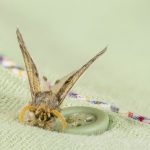
Textile Pest control in Melbourne
‘Textile pests’ is a general term for insects who feed upon and damage stored clothing, carpeting, tapestries, or other fibre products. In practice, this includes various species of moths and beetles, the most common of which are the Clothes Moths and Carpet Beetles.
Textile pests are unusual in that they can digest the protein keratin which is the principal constituent of wool, animal hair and feathers and can be found in any textile of animal origin including mohair, silk, leather and feathers. Many of the textile pests are also pests of stored foodstuffs.
At least ten types of textile pests have been recorded in Australia. It is mainly the introduced species, which EPC – Enviro Pest Control commonly find in homes or businesses.
EPC – Enviro Pest Control finds the most frequently encountered species include:
- Variegated, (or Varied), Carpet Beetle (Anthrenus verbasci)
- Approx. 2-3 mm long
- Mottled yellow, grey and black
- Oval shape similar to a ladybird
- Females lay 60-100 eggs at a time
- Larvae hatch within 7 to 35 days.
- Larvae up to 4-5 mm long when fully fed
- Very slow moving, adults often seen at windows trying to get outside to pollen on flowers
- Larvae between 3- 4.5 mm, resembles a beetle more than a caterpillar
- Adult lifespan, 9-12 months
- Case-bearing Clothes Moth (Tinea pellionella)
- Approx. 7-10 mm long
- Forewings are silvery-grey brown with 3 dark spots
- Females lay eggs in clusters of between 50 and 200
- Life cycle 3- 8 months
- Dislikes light and frequents dark areas. Often scurries across surfaces instead of flying when disturbed
- Larvae up to 10 mm long when full grown
- Cream caterpillar with dark brown head
- Prefers undisturbed areas
- Common or Webbing Clothes Moth (Tineola bisselliella)
- Approx. 8-10 mm long
- Golden beige in colour
- Similar behaviour to case-bearing clothes moth
- Females lay eggs in clusters of between 50 and 200
- Life cycle 3- 8 months
- Larvae up to 12 mm long when full grown. Often found in a network of silken tubing
- Cream translucent caterpillar with dark brown head
EPC’s more rarely encountered species include:
- Tapestry moth (Trichophaga tapetzella)
- Two coloured wings, black towards the head and white behind
- Wingspan about 19 mm
- Females lay eggs in clusters of between 30-200
- Complete in approx. 3-6 months
- Larvae may grow to about 15 mm long
- Prefers coarse materials and constructs silk-lined galleries
- Australian carpet beetle (Anthrenocerus australis)
- Approx. 2-3 mm long
- Dark body with lighter markings
- Females lay 40-100 eggs
- Oval shaped. Lifecycle takes 9-12 months
- Larvae reddish brown, covered with bristles. Elongate oval shaped, with some long hairs trailing from tip of abdomen
- Furniture carpet beetle (Anthrenus flavipes)
- Approx. 2-3.5 mm long
- Mottled yellow, white and black markings
- Females lay 60-100 eggs
- Completes lifecycle in 9-12 months
- Dark colour larva up to 5 mm long when fully fed
- Wide at front, narrow towards the rear
- Brown house moth (Hofmannophila pseudospretella)
- brown with dark speckles and spots on wings
- Approx. 2 mm long
- Prefers damp humid conditions
- Black carpet beetle (Attagenus unicolor)
- Approx. 3-5 mm long
- Shiny black to dark brown, with brownish legs
- Life cycle 9-12 months
- Females lay around 100 eggs
- Larvae up to 7 mm long when fully fed
- Larvae reddish brown covered with stiff bristles
- Relatively widespread and destructive
- Often associated with bird- nesting in roof cavities
It is important to contact EPC – Enviro Pest Control to deal with these pests as soon as you discover them. When you see an adult moth or beetle, the damage is already done as they will have laid their eggs and when the larvae emerge from the egg, they are the part of the life cycle that cause the damage to your clothing, carpet, rugs, and furniture.
Signs of Textile Pest Infestation
EPC – Enviro Pest Control recommends you be familiar with the signs and inspect for pest evidence to detect activity and locate the source of the infestation.
- Presence of the actual insect, alive or dead, at various stages of its development
- Cast skins or other body parts
- Chewing marks
- Small holes in clothing
- Exit holes in surfaces of wood
- Hair, fur or feather loss
- Webbing
- Frass (debris or excrement produced by insects, usually a soft powdery material)
- Faecal pellets, dried stains or faecal spots It is usually these signs, rather than the actual pest, that are detected first
Fun Facts about Textile Pests
- Carpet beetles hate minty fragrances
- Variegated carpet beetles get their name from the rainbow of colour on their backs
- Clothes moths are one species of moths that are not attracted to light, in fact, they avoid light
Why choose EPC – Enviro Pest Control?
If you live in Melbourne and have a Textile Pest problem of any size, you should choose us to help you solve it because:
- EPC – Enviro Pest Control technicians are Trained Specialists and are very experienced at getting rid of textile pests
- We arrive on time
- EPC – Enviro Pest Control technicians are discreet, friendly and professionally presented
- Fairly priced service with advice to help prevent textile pests coming back
- EPC – Enviro Pest Control supply pest control services, including textile pests are effective
If you have a textile pest infestation or even just want to prevent one, call us at EPC – Enviro Pest Control today on 03 9988 5066.
